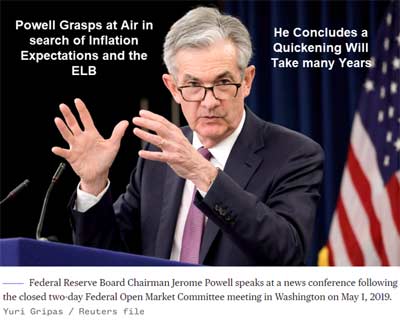The Fed Promotes a Quickening that Takes Many Years
Mish Shedlock
 In the minutes of the June 9-10 FOMC meeting, the Fed discussed racism, Covid, Forward Guidance, Asset Purchases, and Yield Curve Caps. In the minutes of the June 9-10 FOMC meeting, the Fed discussed racism, Covid, Forward Guidance, Asset Purchases, and Yield Curve Caps.
Please consider the Minutes of the Federal Open Market Committee for June 9-10, lead image from Powell Wants to Talk Policy, but all Fed block quotes are from the FOMC Minutes.
Discussion of Forward Guidance, Asset Purchases, and Yield Curve Caps
Participants discussed tools for conducting monetary policy when the federal funds rate is at its effective lower bound (ELB). The discussion addressed two topics: (1) the roles of forward guidance and large-scale asset purchase programs in supporting the attainment of the Committee's maximum-employment and price-stability goals and (2) in light of the foreign and historical experience with approaches that cap or target interest rates along the yield curve, whether such approaches could be used to support forward guidance and complement asset purchase programs.
Effective Lower Bound
That discussion shows the Fed is concerned that it cannot lower rates further.
The Effective Lower Bound is the point at which lowering rates are counterproductive. That means the Fed cannot or will not set rates negative, a position I have held for years.
Yet, many still clamor for them despite negative results in Europe and Japan.
Simulations
The staff presented results from model simulations that suggested that forward guidance and large-scale asset purchases can help support the labor market recovery and the return of inflation to the Committee's symmetric 2 percent inflation goal. The simulations suggested that theCommittee would have to maintain highly accommodative financial conditions for many years to quicken meaningfully the recovery from the current severe downturn.
Meaningfully Quicken
If you announce to the world you will be accommodative for "many years", what further good is forward guidance?
Risks
The staff cautioned that businesses and households might not be as forward looking as assumed in the model simulations, which could reduce the effectiveness of policies that are predicated on influencing expectations about the path of policy several years into the future. Alternatively, prompt and forceful policy actions by the Committee might help focus the public's expectations around better outcomes or reduce perceived risks of worst-case scenarios, which could generate more immediate macroeconomic benefits than those featured in the staff analysis.
Consumers Might Not Follow Models
That isn't a risk. It's a certainty.
Yield Curve Caps
The second staff briefing reviewed the yield caps or targets (YCT) policies that the Federal Reserve followed during and after World War II and that the Bank of Japan and the Reserve Bank of Australia are currently employing. The staff noted that these three experiences suggested that credible YCT policies can control government bond yields, pass through to private rates, and, in the absence of exit considerations, may not require large central bank purchases of government debt. But the staff also highlighted the potential for YCT policies to require the central bank to purchase very sizable amounts of government debt under certain circumstances—a potential that was realized in the U.S. experience in the 1940s—and the possibility that, under YCT policies, monetary policy goals might come in conflict with public debt management goals, which could pose risks to the independence of the central bank.
Yield Curve Cap Summation
They may work or they may not. How enlightening.
Meanwhile, please look at Japan and note that it has neary cornered the entire bond market.
What good did caps do?
Credibility
A number of participants spoke favorably of forward guidance tied to inflation outcomes that could possibly entail a modest temporary overshooting of the Committee's longer-run inflation goal but where inflation fluctuations would be centered on 2 percent over time. They saw this form of forward guidance as helping reinforce the credibility of the Committee's symmetric 2 percent inflation objective and potentially preventing a premature withdrawal of monetary policy accommodation.
Credibility? There is no credibility.
More importantly, the Fed does not even know inflation is. They have blown bubble after bubble and do not see it.
Inflation Expectations
With regard to inflation, participants reiterated their view that the negative effect from the pandemic on aggregate demand was likely to more than offset any upward pressure from supply constraints so that the overall effect of the outbreak on prices was seen as disinflationary. Consistent with that interpretation, participants observed the recent negative readings on the monthly CPI and noted that they anticipated that the 12-month PCE inflation measure would likely run well below the Committee's 2 percent objective for some time. Observing that inflation had been running somewhat below the Committee's 2 percent longer-run objective before the coronavirus outbreak, some participants noted a risk that long-term inflation expectations might deteriorate. Participants noted that a highly accommodative stance of monetary policy would likely be needed for some time to achieve the 2 percent inflation objective over the longer run.
Three Wrong Economic Models
- Deflation Group-Think
- Inflation Expectations
- Phillips Curve
At the top of the list of widely-believed but false central bank economic theories is the notion that falling retail prices are bad for the economy.
Nonsense After Nonsense
The minutes are nothing but complete nonsense after nonsense. Starting with inflation expectations, I have some questions.
Inelastic Item Questions
Q: If consumers think the price of food will drop, will they stop eating? Will they eat twice as fast if they expect prices will rise?
Q: If consumers think the price of gas will drop, will they stop driving?
Q: If consumers think the price of rent will drop, will they hold off renting until that happens? Will they rent two apartments if they expect the price to rise?
Q: Will consumers delay medical services if they think prices will drop? Will they have two operations if they think prices will rise?
Elastic Item Questions
Q. If someone needs a refrigerator, toaster, stove or a toilet because it broke, will they wait two months if they think prices will decline?
Q. Better deals on TVs and computers are always around the corner. Does that stop TV and computer purchases?
Answers to those questions prove inflation expectations are total nonsense.
Asset Price Expectations
- People do buy stocks it they believe prices will rise. They avoid stocks or sell them if they expect prices will drop.
- People will stretch to buy a home if they expect prices to rise. They wait if they expect prices will drop.
But neither houses nor stocks are in the CPI. The Fed does not consider the only places (short of hyperinflation), where expectations matter at all.
For discussion of a CPI basket of goods, please see The Problem is Not Deflation, It's Attempts to Prevent It
Inane Deflation Fears
The BIS study on Costs of Deflations: A Historical Perspective investigated output growth in numerous deflations over a 140-year period, in 38 economies, The study concluded:
- Deflation may actually boost output.
- Lower prices increase real incomes and wealth.
For a discussion of the BIS study, please see Historical Perspective on CPI Deflations: How Damaging are They?
Lies of the Day
Hello Jerome Powell, We Have Questions
On March 25, 2019, roughly a year before Covid hit, I penned Hello Jerome Powell, We Have Questions.
My questions remain unanswered and the Fed still has no idea at all what inflation is.
In Search of the Effective Lower Bound
For discussion of the ELB, please see In Search of the Effective Lower Bound
Very Deflationary Outcome Has Begun: Blame the Fed
By foolishly promoting inflation the Fed sponsored credit bubbles of increasing amplitude over time.
It’s asset asset bubble deflation that is damaging, not routine price deflation.
The irony is a Very Deflationary Outcome Has Begun.
When asset bubbles burst, debt deflation results.
Here we go again.
Mish

Mike Shedlock / Mish is a registered investment advisor representative for SitkaPacific Capital Management.
Sitka Pacific is an asset management firm whose goal is strong performance and low volatility, regardless of market direction.
You are currently viewing my global economics blog which typically has commentary every day of the week.
www.thestreet.com
| 



